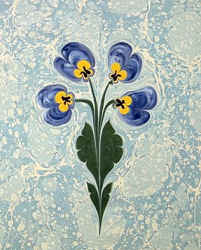 Marbled paper or "Ebru" is an art form that was developed in Central Asia and Ottoman Empire in the fifteenth century. Traditionally, this paper was used for borders on Ottoman panels and miniatures, and for the inside covers and flyleaves of books. In the 17th century European travelers collected examples of these papers and thus the Ebru art was introduced to Europe, where it became very popular too.
Marbled paper or "Ebru" is an art form that was developed in Central Asia and Ottoman Empire in the fifteenth century. Traditionally, this paper was used for borders on Ottoman panels and miniatures, and for the inside covers and flyleaves of books. In the 17th century European travelers collected examples of these papers and thus the Ebru art was introduced to Europe, where it became very popular too.
In order to perform the Ebru art a shallow tray is filled with water and some viscous material such as gum and the gall fluid of cattle. This viscous liquid makes the colors floating on the water. Various mineral and vegetable dyes are sprinkled and carefully applied to the surface of the water with a small brush. Depending on the creativity of the artist, drops of negative colors are put on floating colors; or the already existing and floating dyes in the water are gently manipulated with a thin brush or by blowing on them directly or through a straw. The process is repeated until the surface of the water is covered with unique and unrepeatable patterns, flower designs, circles, etc. A blank sheet of paper is laid on the water for few minutes so the floating colors are transferred to the paper. Than the paper is carefully removed from the tray and naturally dried.
Today mass-produced marbled paper is used for many decorational purposes, though the art of marbling continues. It's a very popular art in Turkey, there are many artists and art houses still producing traditional Ebru, especially in Istanbul.
In 2014 Ebru art was inscribed in the UNESCO's List of Representative List of the Intangible Cultural Heritage of Humanity.

